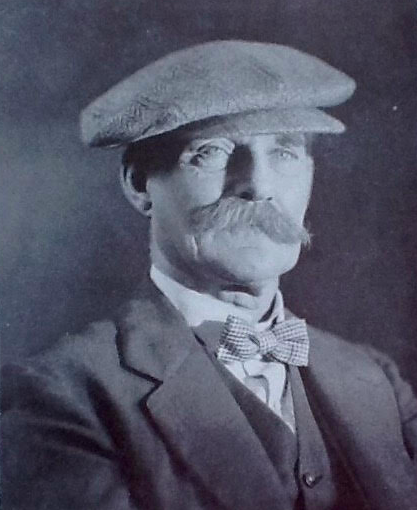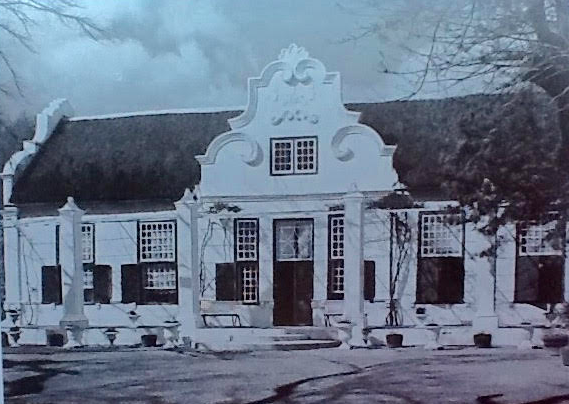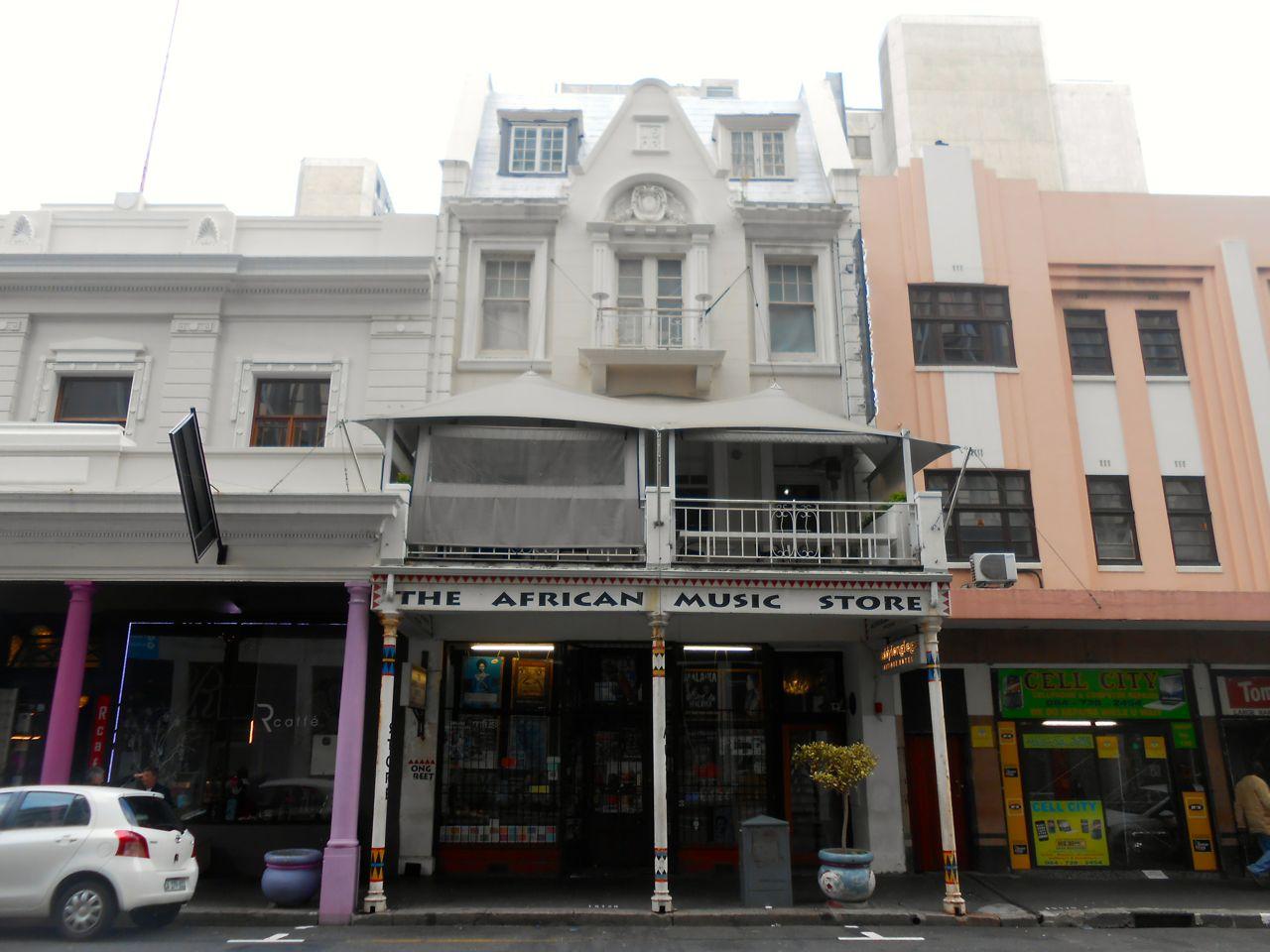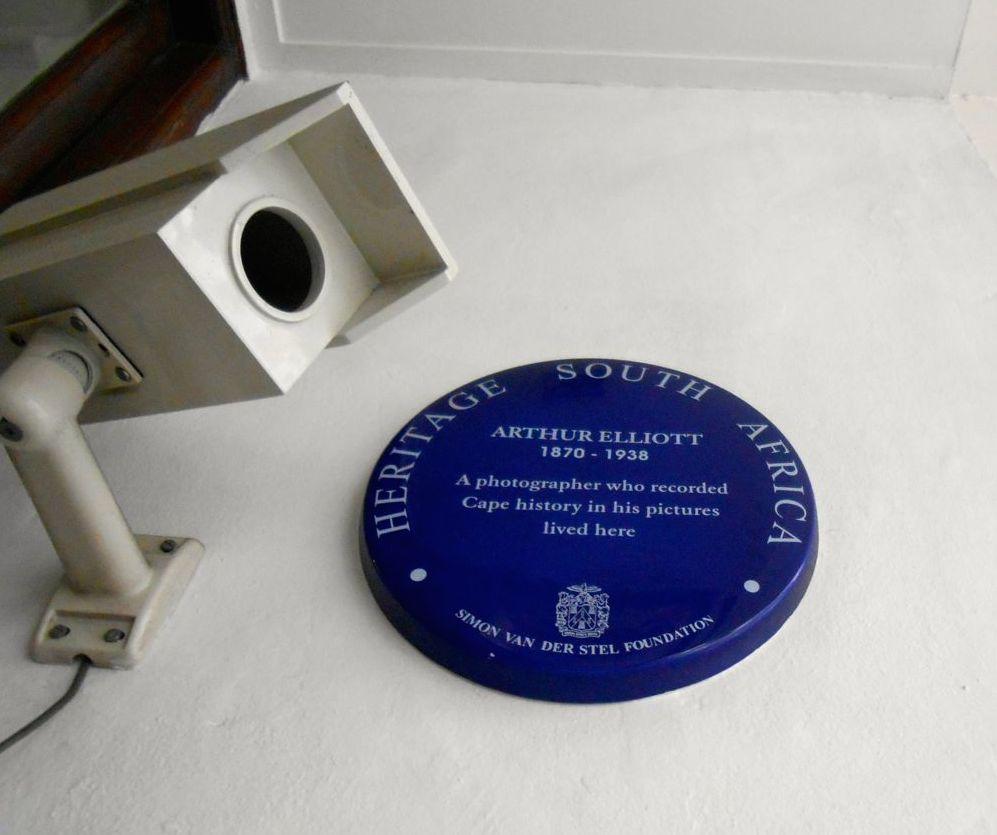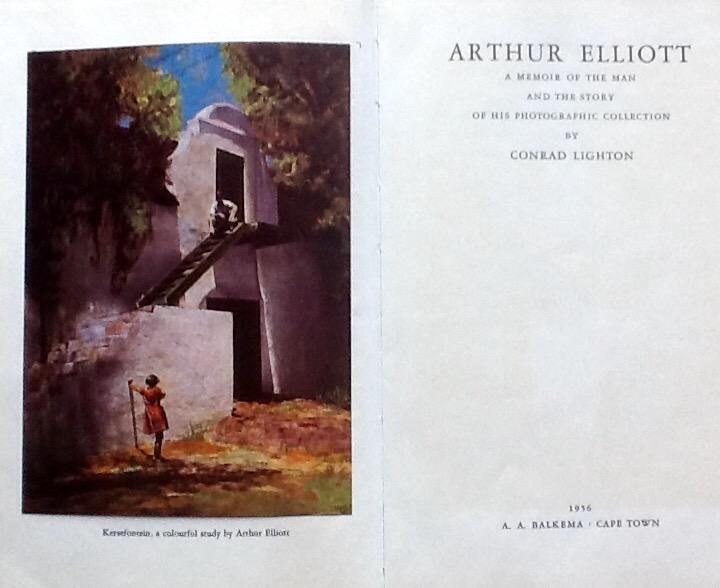
A pleasure and delight of combing a bookshop in a random way (this is what browsing means) is that you are guaranteed to make a 'find'. A serendipitous happy find you never knew about but it instantly becomes a prized possession. A recent visit to Bookdealers of Melville yielded just such a small delight. It is a thinning small book on Arthur Elliott, the photographer of the architecture of the Cape and the master of black and white, light and shadow images of Cape scenes. Arthur Elliott (b. 1870, d. 1938) was American born and it was not until he was 30 that he took to photography, that is, circa 1900.
This small book by Conrad Lighton tells his story. Published in 1956, nearly 20 years after his death, it introduces a marvelous selection of Elliott's black and white Cape studies (there are 30 plates). Elliott made his name as a South African photographer over the period 1900 to 1938. His strength was architectural studies and the details of the Cape Dutch style. He was the photographer who opened people's eyes to the specific... gables, bell towers, moulded pediments, fan lights, doorways and so aroused interest in the distinctiveness of Cape homesteads and the Cape Dutch heritage. The romantic dreamy images had viewers of his work falling for his photography but his legacy was to encourage, through the camera eye, the appreciation of the quiet beauty of a style that was traditional, dated and disappearing. His photographic work made a contribution to heritage appreciation and preservation. He lived in a time when photography was technically difficult, required an artist's eye and enormous patience to get the match and mix of light and shadow right. A master photographer is one who helps us to see the familiar with fresh insights, and as Lighton says because of Elliott, he (Lighton) never took this heritage for granted again. It was Elliott's belief that people should read a photograph as they read a book and his exhibitions of hundreds of photographs must have had a powerful impact.
Portrait of Arthur Elliott
This memoir recalls Elliott, tells us about a special personality and his take on a life that led from early poverty and a hard childhood in the USA and Britain to an experimental wandering youth. He tried a number of promising career options, a chemist shop assistant, a jack of all trades in a whisky shop (though he was a teetotaler all his life). He went to sea and tried tugboats, cattle boats and passenger steamers. He was a salesman, a railway worker in India and had a disastrous brief spell as a watchmaker.
He arrived in South Africa in the late 1880s and the memoir provides a fascinating account of his efforts as a scenery painter in Johannesburg for the London Dramatic Company. Here are some marvelous vignettes of his years employed by the impresario Luscombe Searelle at the Theatre Royal in Johannesburg. I love the story of Elliott painting Elsinore castle stones in a performance of Hamlet with a golden paint as this would be appreciated by Johannesburg gold hunters. Elliott was the man who introduced the first phonograph (Edison's invention) to the Transvaal and like an early camera, the photography was kept in a little black box. Here was a man of spirit and verve who enjoyed many adventures. He may also have practiced as a photographer in Pretoria and one assumes that this was after 1900.
Morgenvliet Somerset West
In 1900 Arthur Elliott arrived in Cape Town as a Boer War refugee and it was there that he found his niche in life. There was no stopping him. He established a studio, held increasingly noticed prestigious exhibitions, and grew an impressive collection of photographs and plates. His speciality was in collecting pictures that provided a pictorial record of the past and the 19th century characters who by the 20th century were fading from the scene. He wanted his collection to be as historically comprehensive as possible. For 32 years Arthur Elliott lived and worked from a studio combined with flat at 134 Long Street in Cape Town. He remained a bachelor all his life but almost like Lewis Carroll, was a favourite uncle to many little friends; he transitioned into Uncle Arthur with cloth cap, an amiable expression and bushy mustache. He was a man of humour, approachability, friendliness, kindness and yet reserved. His best known and most popular photograph was called the Sandpipers, a naked child flautist on the beach sand of Fish Hoek Dunes, charming two sandpipers; the secret of the photograph was that there was one stuffed bird and the second one alive and real!
Where Elliott lived on Long Street (The Heritage Portal)
Blue Plaque (The Heritage Portal)
This is the Arthur Elliott story succinctly and well told. I like the combination of Elliott's own photographs and those he collected. For example, one of what Adderley Street looked like in 1880. By the end of his life his collection was impressive and an American institution offered £7000 but he was ready to keep it in South Africa for a price of £5000. There was an appeal to raise this purchase price but it failed and it was not until after his death in 1938 that the Historical Monuments Commission acquired the Elliott collection for the much lower figure of £2525. Elliott never lived to know that his collection had been secured for his adopted country. As Lighton concludes, Arthur Elliott was the man who found his destiny in a Camera. His collection has been heavily used by architectural historians of the Cape ever since.
This small volume is an addition to my growing though small collection of books on South African photographic history. I am pleased to learn more about Elliott and his photographic world. Elliott gave a priceless gift to South Africa with his talents and his legacy.
2019 Price Guide: Antiquarian purchase R150 to R200
Addendum
The reputation of Arthur Elliott has grown in the years since his death, but was remembered in the 1960s.
In 1967 Denis Hatfield gathered together a series of 50 brief talks that he and others had done for the English medium Radio South Africa in a book called Some South African Monuments. The book was published by Purnell. It’s an attractive volume and fits into a South African heritage library. One of the talks was on Arthur Elliott and his work as a photographer. Elliott died in 1938. There was a memorial plaque to Elliott on Long Street and honoured him because Elliott’s collection of 10 000 photographic negatives was bought by the Historical Monuments Commission in 1940 and was deposited in the Cape Archives. Elliott did not sell his collection in his life time and died in penury. His collection was only sold after his death and at the time there was clearly some uncertainty over the right price to be paid for such a collection. How would one value such a unique collection, most especially if the right repository was a state institution?
Elliott today is commemorated in Cape Town with a blue plaque (see image above). Thus the earlier rectangular bronze plaque would almost have been a forerunner to the blue plaques of the Simon van der Stel Foundation. It was to be found at 134 Long Street - it read “ On this site lived Arthur Elliott, An American Gentleman, who made the Cape his home and the record of her history in photographs his life work – 1870 -1938”.
Kathy Munro is an Honorary Associate Professor in the School of Architecture and Planning at the University of the Witwatersrand. She enjoyed a long career as an academic and in management at Wits University. She trained as an economic historian. She is an enthusiastic book person and has built her own somewhat eclectic book collection over 40 years. Her interests cover Africana, Johannesburg history, history, art history, travel, business and banking histories. She researches and writes on historical architecture and heritage matters. She is a member of the Board of the Johannesburg Heritage Foundation and is a docent at the Wits Arts Museum. She is currently working on a couple of projects on Johannesburg architects and is researching South African architects, war cemeteries and memorials. Kathy is a member of the online book community the Library thing and recommends this cataloging website and worldwide network as a book lover's haven.

